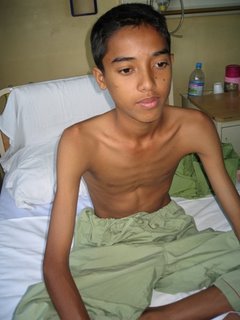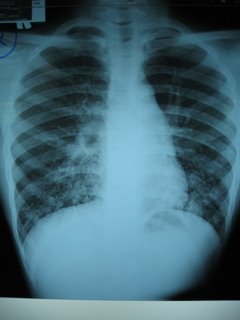Crepitations and Clubbing
Record :
This young boy is tachypnoic at rest with a RR 24/min. There is clubbing noted, no HPOA or evidence of CO2 retention. There is no pallor, jaundice or cyanosis. JVP is not elevated. Trachea is central and apex beat not displaced. There is no cervical L/N enlargement. There is no pedal oedema of the legs. There are coarse inspiratory crepitations over bilateral lower zones.
I would end my examination by checking the sputum pot, temperature chart and other lymph nodes
My diagnosis is that this pt has bronchiectasis and is tachypnoeic. Possible cause include resp infection in childhood.
dDX of creps and clubbing -
ca. of lung, fibrosing alveolitis, lung abscess
Ix - CXR, HRCT, Sputum culture
This young boy is tachypnoic at rest with a RR 24/min. There is clubbing noted, no HPOA or evidence of CO2 retention. There is no pallor, jaundice or cyanosis. JVP is not elevated. Trachea is central and apex beat not displaced. There is no cervical L/N enlargement. There is no pedal oedema of the legs. There are coarse inspiratory crepitations over bilateral lower zones.
I would end my examination by checking the sputum pot, temperature chart and other lymph nodes
My diagnosis is that this pt has bronchiectasis and is tachypnoeic. Possible cause include resp infection in childhood.
dDX of creps and clubbing -
ca. of lung, fibrosing alveolitis, lung abscess
Ix - CXR, HRCT, Sputum culture
Labels: Respiratory











6 Comments:
Sometimes, we are confuse with coarse vs fine creps. Just remember fine creps= sound of rubbing hair
Young boy, creps , clubbed Remember to ask pt to cough to see if creps or craclkles get better ( as they dont change in fibrosis)
DDX 1 - early childhood infections( whooping cough , measles ) and most comonly cystic fibrosis . commonest cause of worldwide bronchietasis is early childhood infections then cystic fibrosis , then others like Kartageners syndrome, primary hypogammaglobulinemia, then unilateral and local causes from obstruction by foreign body, LN , Tumour,
I had my 2nd attempt at the paces in newcastle on the 17th of june 2007. My respiratory case was a 70 yr old man who has SOB.On examination he was tachypiec at rest otherwise no significant findings on generation examination.In the chest,he had lt thoracotomy scar and another small scar for possiblly chest tube or thoracoscope.The tracheal slightly deviate to the lt with reduce expasion and TF.And he had dull percusion same zone ,but had bibasal creps.I concluded that the patient had bronchiectasis with lt lobectomy.I was asked the differential and i gave possibility of bronchogenic cancer and lobectomy.The examination then ask that if the thoracotomy was do when patient was 17 yrs old what do i think .I said it could be that he has post measles bronchietasis with lt lobectomy,the examiner then smiled and the bell rang.I am alittle worried b/c he wrote dopwn all my signs.
I would like to comment on CXR:
prominent pulmonary conus
prominent central pulmonary arteries
,peripherasl lung oligaemia
all point to pulmonary artery hypertension which could be secondary to chronic lung disease like bronchiectasis
I would like to comment on CXR:
prominent pulmonary conus
prominent central pulmonary arteries
,peripherasl lung oligaemia
all point to pulmonary artery hypertension which could be secondary to chronic lung disease like bronchiectasis
Crepitations in bronchiectasis are pan broncheal. Tractional bronchiectasis can occur with long standing foci of fibrosis.
Post a Comment
<< Home